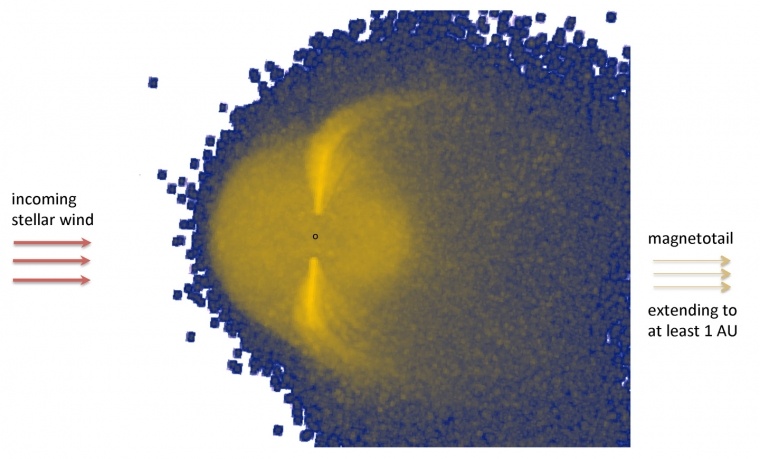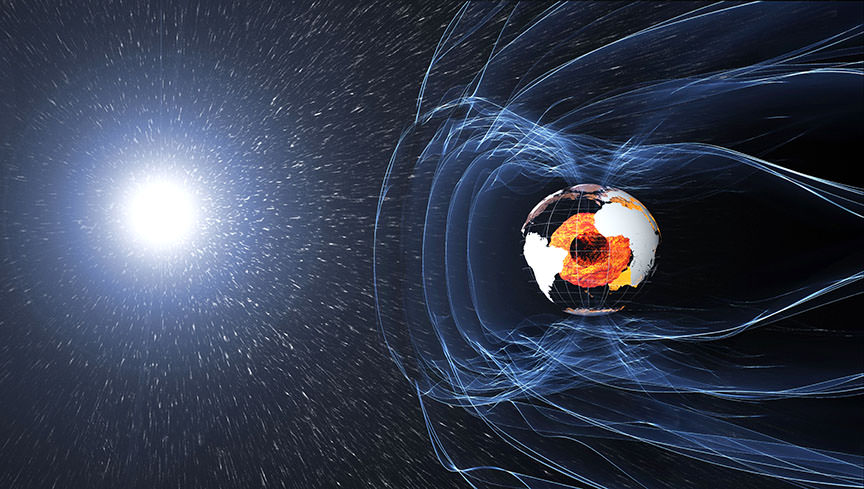Today’s astronomers are busy building the census of extrasolar planets, which has reached a total of 4,884 confirmed planets, with another 8,288 candidates awaiting confirmation. Now that the James Webb Space Telescope (JWST) has finally been launched, future surveys will be reaching beyond mere discovery and will be focused more on characterization. In essence, future exoplanet surveys will determine with greater certainty which planets are habitable and which are not.
One characteristic that they will be on the lookout for in particular is the presence of planetary magnetic fields (aka. magnetospheres). On Earth, the atmosphere and all life on the surface are protected by a magnetic field, which is why they are considered crucial to habitability. Using data from the venerated Hubble Space Telescope (HST), an international team of astronomers reported the detection of a magnetic field around an exoplanet for the first time!
The team consisted of astronomers from the University of Arizona’s Lunar and Planetary Laboratory (LPL), NASA’s Jet Propulsion Laboratory (JPL), the European Space Astronomy Centre (ESAC), the Harvard-Smithsonian Center for Astrophysics (CfA), the Institut d’Astrophysique de Paris, the Zentrum für Astronomie und Astrophysik, the Centro de Astrobiología (CSIC-INTA), the Groupe de Spectroscopie Moléculaire et Atmosphérique (GSMA), and multiple Universities. Their findings appeared in a paper recently published by the journal Nature Astronomy.
 The “invisible” world Kepler-19c, a possible “mini-Neptune,” is seen in the foreground of this artist’s conception. Credit: David A. Aguilar (CfA)
The “invisible” world Kepler-19c, a possible “mini-Neptune,” is seen in the foreground of this artist’s conception. Credit: David A. Aguilar (CfA)
Using Hubble data, the team observed HAT-P-11b, a Neptune-sized exoplanet that orbits a K-type (orange dwarf) star located 123 light-years from Earth. This is what is known as the Transit Method (aka. Transit Spectroscopy), where periodic dips in a star’s brightness indicate that a planet or other celestial body is passing in front of it (or “transiting”). In addition to being the most popular and effective means of exoplanet detection, this method can also reveal spectra from exoplanet atmospheres.
While observing HAT-P-11 in the ultraviolet spectrum, the team witnessed the planet make six transits. Hubble detected carbon ions (charged particles) surrounding the planet during these transits. According to the team’s paper, the most likely explanation is the presence of a magnetosphere interacting with carbon ions as they escaped the planet’s atmosphere into space.
Gilda Ballester, an adjunct research professor at the University of Arizona and a co-author on the paper, is also a principal investigator of a Hubble program that observed HAT-P-11b. As she explained in a recent LPL press release:
“This is the first time the signature of an exoplanet’s magnetic field has been directly detected on a planet outside our solar system. A strong magnetic field on a planet like Earth can protect its atmosphere and surface from direct bombardment of the energetic particles that make up the solar wind. These processes heavily affect the evolution of life on a planet like Earth because the magnetic field shelters organisms from these energetic particles.”
 Illustration of Hubble’s observations of HAT-P-11b and the extended region of charged carbon particles that surround it and form a long tail. Credit: Lotfi Ben-Jaffel/Institute of Astrophysics, Paris
Illustration of Hubble’s observations of HAT-P-11b and the extended region of charged carbon particles that surround it and form a long tail. Credit: Lotfi Ben-Jaffel/Institute of Astrophysics, Paris
Another key discovery was how carbon ions were not only observed around the planet but were also seen extending a long way from the planet (the “magnetotail”). This tail extends to a distance of at least one astronomical unit (1 AU) into space – the same distance between the Earth and Sun – while the particles traveled at an average speed of 160,935 km/h (100,000 mph). While the physics of this magnetosphere is the same for Earth, HAT-P-11b orbits much closer to its star (1/20th of 1 AU).
This proximity causes the upper atmosphere to warm and essentially “boil off” into space, which releases neutral hydrogen and carbon ions. As Ballester explained:
“Just like Earth’s magnetic field and its immediate space environment interact with the impinging solar wind, which consists of charged particles traveling at about 900,000 mph, there are interactions between HAT-P-11b’s magnetic field and its immediate space environment with the solar wind from its host star, and those are very complex.”
While a mini-Neptune like HAT-P-11b is not a good candidate for habitability, the first unambiguous detection of a magnetosphere is a significant step toward an improved understanding of exoplanet habitability. To date, many studies of potentially-habitable exoplanets have been limited because astronomers are not yet able to constrain the magnetic properties of exoplanets. In particular, astronomers are curious whether rocky planets that orbit M-type red dwarf stars can hold onto their atmospheres, given the flare-ups they’re subjected to.
 The magnetic field and electric currents in and around Earth generate complex forces that have an immeasurable impact on everyday life. Credit: ESA/ATG medialab
The magnetic field and electric currents in and around Earth generate complex forces that have an immeasurable impact on everyday life. Credit: ESA/ATG medialab
Earth is the only rocky body within our Solar System to have its own magnetic field. While the gas giants and Ganymede (one of Jupiter’s largest moons) all possess magnetic fields, these bodies cannot support life on their surfaces. In addition, the disappearance of Mars’ magnetic field (ca. 4 billion years ago) is what led to its atmosphere being stripped away by solar wind. This is how Mars’ surface became the cold, desiccated, and irradiated place it is today.
The connection between magnetic fields and habitability is not yet fully understood and requires further investigation. Luckily, this study and the methods employed show that magnetospheres can be detected around various exoplanets to assess their role in potential habitability. “HAT-P-11 b has proven to be a very exciting target because Hubble’s UV transit observations have revealed a magnetosphere, seen as both an extended ion component around the planet and long tail of escaping ions,” said Ballester.
Another interesting find was the metallicity of HAT-P-11 b’s atmosphere, which was lower than expected. While all of the gas giants in the Solar System are primarily composed of hydrogen and helium, they vary in terms of their metallicity and magnetic fields. Whereas Jupiter and Saturn have low metallicities but strong magnetic fields, the “ice giants” Uranus and Neptune have high metallicities and weak magnetic fields. HAT-P-11 b’s low atmospheric metallicity, say the authors, challenges current models of exoplanet formation.
“Although HAT-P-11 b’s mass is only 8% of that of Jupiter, we think the exoplanet more resembles a mini-Jupiter than a Neptune,” Ballester said. “The atmospheric composition we see on HAT-P-11b suggests that further work needs to be done to refine current theories of how certain exoplanets form in general.”
If there’s a takeaway from this research, it’s that we still have plenty to learn about exoplanets and what it takes to ensure planetary habitability. But we’re rapidly learning, and the pace will only accelerate as next-generation telescopes become operational – like the James Webb Space Telescope (JWST), which just launched! With thousands of new worlds to explore, the search for extraterrestrial life will progress from an art to a science!

